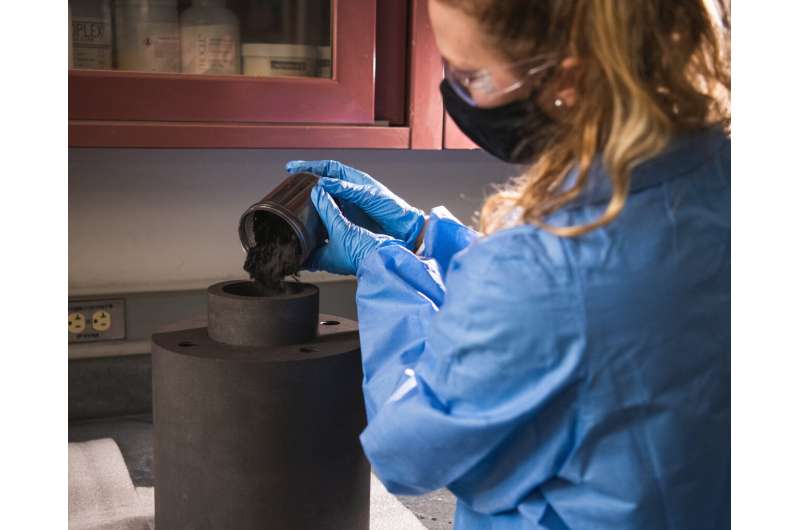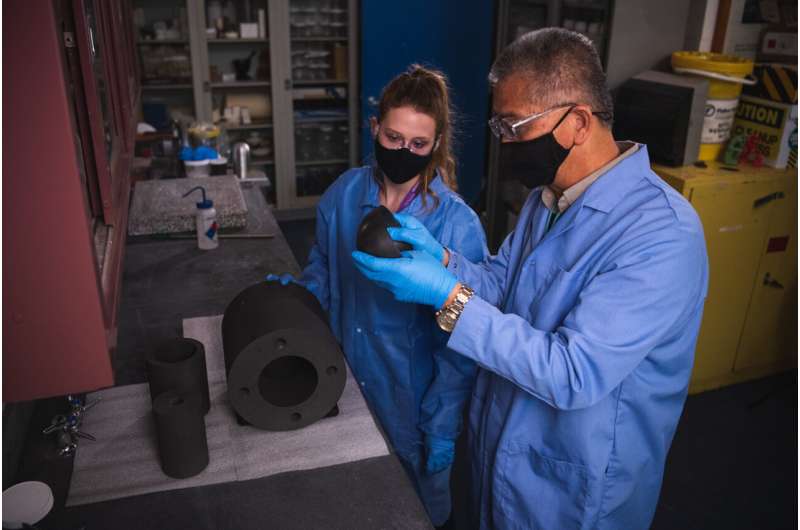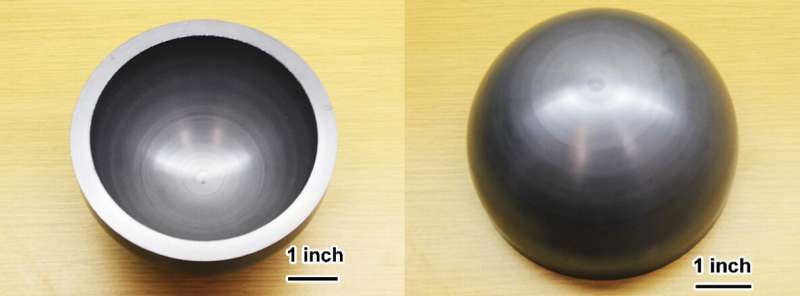Manufacturing technology could transform production of critical components

If a coffee cup fails to survive an unexpected engagement with gravity, its replacement is just a few dollars away. But not all ceramics or metals can afford to fail—the precision components inside a nuclear reactor, the turbine engine inside an aircraft, the body armor to protect a soldier's head and neck. To meet needs for industrial applications where there is little tolerance for failure, researchers at Los Alamos National Laboratory have developed a near-net-shape manufacturing technology to more efficiently produce higher quality, more reliable components.
The novel pseudo-hot-isostatic-pressing (P-HIP) technology enables the manufacturing of complicated shapes using uniaxial hot pressing with near-net shape capability, meaning items emerge very close to their final shape.
"This is a transformational concept for the ceramics and powder metallurgy industries," said Chris Chen, researcher in the Sigma Fabrication Manufacturing Science group at the Laboratory. "Hot-pressing of ceramic and metal powders has been used to produce a wide variety of advanced ceramics and materials for nearly 100 years. However, little improvement has been implemented since this technique was initially developed, and limitations such as the performance quality and variety of shapes that can be made are persistent challenges, particularly in uniaxial hot-pressing."
An improved process for better performance
The P-HIP concept improves upon the shapes achieved through conventional uniaxial hot-pressing, in which external pressure is applied from top and bottom on materials under high heat. In conventional hot-pressing of that kind, only simple shapes such as cylinders, cubes and discs can be achieved. Further refining the shape—a thin-walled Certifiable Test Object, for instance—then involves energy- and time-intensive machining. P-HIP also improves upon pressureless sintering, a popular technology for manufacturing components without any external pressure. Compared to the P-HIP process, components produced by pressureless sintering tend to have higher porosity, or void space, which contributes to lower performance.

Working over several years at the Advanced Ceramics Processing Laboratory at Los Alamos, Chen and his team developed a near-net-shape P-HIP to produce high-performance ceramic or metal with a combination of important properties: versatile and complicated shape, high density, uniform density distribution and minimal amounts of machining required. The products' enhanced mechanical properties mean higher strength to withstand severe stress and survive longer, better electrical properties offer better conductivity, stronger magnetic properties mean a stronger magnetism, and so on.
"What we've found is that P-HIP can outperform other manufacturing technologies, including conventional hot-pressing, slip-casting, cold-isostatic-pressing, extrusion, injection molding and additive manufacturing," said Chen. "P-HIP technology delivers high added-value and will increase the performance and reliability of critical components for the nation and for a wide array of industries."
A process with transformative applications
The P-HIP technique uses graphite flakes, hexagonal boron nitride powder, or other appropriate solid lubricant to replace the solid graphite punch used in conventional hot pressing. The solid lubricant can easily slide, redistributing stress from high-stress concentration areas to low-stress concentration areas, a self-stress-relief action. The graphite flake or hexagonal boron nitride powder lubricants can withstand temperatures up to 3,000 degrees Celsius. The method provides substantially uniform pressure that can create near-net-shape parts that also have high density distributed more evenly through the whole part.

The process produces stronger, more complicated and more reliable parts, with fewer rejections, saving energy, time and cost on finish machining.
P-HIP could well be applied to building fall-proof coffee mugs. But its most transformative applications may be to those materials that either have a prohibitive cost for failure, such as oil and drilling parts, turbine engines, nuclear reactor components; or cannot afford to fail at all, such as soldiers' head protection, airplane engines or satellite equipment. Ultimately, the technology may measure its savings not just in dollars and cents, but in the health of the environment and the enhancement of human safety.
Provided by Los Alamos National Laboratory




















